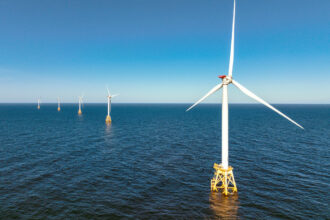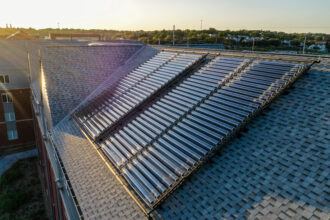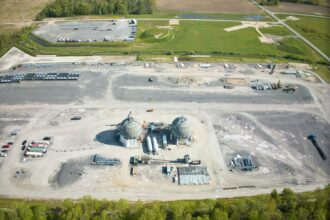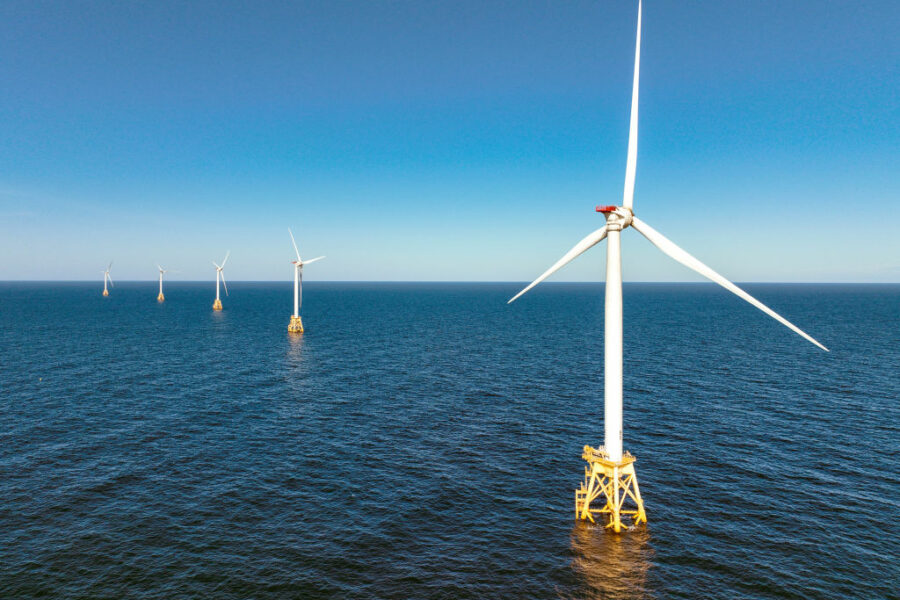From our collaborating partner “Living on Earth,” public radio’s environmental news magazine, an interview by managing producer Jenni Doering with reporter Nicholas Kusnetz of Inside Climate News. The interview has been edited for length and clarity.
Hydrogen is getting a lot of attention as a key potential fuel source to replace fossil fuels in the future clean energy economy, because when it’s burned the end product is simply water.
With help from funding from the Bipartisan Infrastructure Law, that future may soon be a reality. After a competitive application process, President Biden recently announced the recipients of up to $7 billion in grants for seven hydrogen hubs across the country. Each “hub” will include a network of producers, consumers, and transporters of hydrogen, creating a model for what this new energy market might look like.
But replacing fossil fuels with hydrogen isn’t necessarily guaranteed to bring climate benefits.
JENNI DOERING: What are the Biden administration’s goals in creating these hydrogen hubs? Why are they investing this money?
NICK KUSNETZ: The hope is that hydrogen could play an important role in helping to cut the nation’s climate emissions and climate pollution. And in particular, the hope is that hydrogen could play a role in a number of sectors for which there aren’t really good options right now. And in fact, the legislation that created these hubs spelled out some of them.
A big one is heavy industry—things like steel making, you could use hydrogen where the steel plants are currently using natural gas. Hydrogen could also be used for long haul trucks. And in that case, they might be used almost like a battery, in something called a fuel cell. Hydrogen could be used to power ships. It could even be used to make a synthetic jet fuel. Those are what a lot of people see as some of the most promising or important potential places.
But there’s few if any examples of this happening today. And there’s certainly nothing close to the scale that would be needed. So the hubs are meant to start to build a model and test out what works and what doesn’t.
DOERING: Not all hydrogen is created equal. Why is that? And what do we know about where these hubs fall on that spectrum?
KUSNETZ: There are different ways to make hydrogen. And there is already hydrogen production. Hydrogen is used in oil refining, it’s used to make fertilizers. So there’s some existing production. And that’s almost all made from natural gas, in a process that releases a lot of carbon dioxide, so a lot of climate pollution. It’s a dirty process. and the hope is that that can be cleaned up.
One way is to do essentially the same process, but to capture the carbon dioxide emissions, you know, to use technology to pull that out of the smokestacks. And that gas could then be compressed and pumped underground. That’s become known as blue hydrogen. And that is getting a lot of investment and interest from oil and gas companies in particular, because it uses natural gas, so it’d be a new market for their products.
But hydrogen can also be made with electricity. And if that electricity is generated by wind or solar power, an emissions-free source, then you can theoretically make zero emission or extremely low-emission hydrogen, by just [using] electricity to take the hydrogen out of water.
The hubs are investing in all of this. There was legislation that said the hubs had to invest in a number of different sources, but some of them are doing a combination. At least three of them are going to be making hydrogen with natural gas and carbon capture. There are more that are using so-called green hydrogen with renewable energy. The Biden administration said it was two thirds; in some cases, there’s hubs that are doing both.
DOERING: To what extent does blue hydrogen rely on carbon capture technology that actually works?
KUSNETZ: The only way that you would be able to claim to make clean hydrogen from natural gas is if you captured pretty much all of the carbon dioxide that’s released in that process. There are no existing examples of this.
There are a couple of hydrogen projects that do have carbon capture operations. They weren’t really designed to capture 90 plus percent of this carbon dioxide that comes out of them, which is what you’d need. I think you have critics looking at it and saying, like, look, we don’t know if we can do this. It’s never been done. Various attempts to run commercial-scale projects that have those kinds of high capture rates have failed. Supporters say, well, we haven’t really tried, basically.
DOERING: So in terms of blue hydrogen, it’s not the cleanest kind of hydrogen. So why even include it in these hubs?
KUSNETZ: There are a couple of different answers for that. There’s the political answer, which is, of course, it’s a huge constituency, or it’s a very powerful constituency, the fossil fuel industry.
The fossil fuel industry lobbied very hard to make sure that it wouldn’t get cut out from hydrogen funding. Joe Manchin, the West Virginia Senator, and many other members of Congress and people in the White House acted to make sure that natural gas was included.
There are also people who say that we’re going to need to scale this up pretty significantly, and that there are questions about whether we can really make that much hydrogen from just renewable power, whether there will be enough wind and solar power available. The hope from those people is that companies can really figure out how to do it cleanly with natural gas as well, and that you’ll need every tool.
Keep Environmental Journalism Alive
ICN provides award-winning climate coverage free of charge and advertising. We rely on donations from readers like you to keep going.
Donate NowDOERING: How much of a role is the oil and gas industry playing in these hydrogen hubs?
KUSNETZ: The oil and gas industry has a big role in a number of the hubs. There’s the Gulf Coast hub, for example, which is going to be centered around Houston and that part of the Gulf Coast. ExxonMobil is a big player in that one. Chevron is involved. Houston is, of course, the capital of the nation’s oil and gas industry. The Appalachian hub as well has some fossil fuel interests. EQT, which is the nation’s biggest gas producer, is a partner of one of the companies involved in that hub. And there’s some oil and gas companies involved in some of the other hubs, as well as one in the northern Great Plains.
DOERING: How has the oil and gas industry shaped hydrogen policy?
KUSNETZ: The oil industry has played a really big role in the legislation that’s come out of Congress and the policy out of the White House over the last few years. The two big ones are the Bipartisan Infrastructure Bill and the Inflation Reduction Act.
The Infrastructure Bill created these hydrogen hubs, and then the Inflation Reduction Act created a new tax incentive for clean hydrogen that is dependent on how much is produced but could potentially be tens, hundreds of billions of dollars, over a decade. You could think of the hubs as trying to build the model for a clean-hydrogen economy. If they’re the model, then the inflation Reduction Act is actually trying to get that economy built, and trying to provide the money to private industry to really bring it to scale.
The oil and gas industry has been lobbying really hard to make sure that blue hydrogen made with natural gas and carbon capture can qualify for both of these, for the hub funding and for the credits, and they’re continuing to do so. Right now, the Treasury Department is working on the rules that will determine what is clean, exactly, and how to qualify your hydrogen as clean. So the industry is lobbying the White House, it’s lobbying the Treasury Department, on the kind of intricacies of that and how that will be determined.
DOERING: Some of these hubs are located in regions where fossil fuel based jobs have been dominant. To what extent can some of those workers tap into new jobs created by these hydrogen hubs?
KUSNETZ: That’s certainly the goal and the plan. And that was why the legislation directed that at least some of the hubs be in fossil fuel dependent regions. The Appalachian one is a good example. You saw the winner of that hub promising to make thousands and thousands of new jobs, right? And the argument is that these are going to be in some sort of heavy industries that are a good match for some of the jobs that might otherwise be lost. The Biden administration has very much made jobs and employment a big piece of its climate agenda. And this promise that transitioning the nation off of fossil fuels and cutting emissions does not have to just mean the loss of jobs, but the creation of new jobs.
DOERING: To what extent is there an environmental justice requirement here?
KUSNETZ: The question of how these will fit into the administration’s environmental justice goals is a big open one. One of the big critiques so far of this hydrogen hub process has been that the department has not been transparent with what’s happening. Because of that there’s a real concern that these projects will move forward without the kind of level of community engagement that would ensure that they don’t increase pollution for certain communities, because there are ways in which producing hydrogen could increase certain local air pollutants.
If you’re burning more natural gas, even if you capture the carbon dioxide, there can be other air pollutants that affect the air quality of communities. So those wouldn’t necessarily be improved for communities, and could even get worse. The administration has committed to trying to prevent that from happening and trying to include local communities. But certainly local communities don’t feel like they’re living up to that yet.
DOERING: Let’s say these hubs do manage to meet the goals that the Biden administration has set. What could their potential impact be?
KUSNETZ: The impact of the hubs, if they’re successful, could be significant. A lot of people talk about something like 10 percent of the nation’s emissions, global emissions, really, that could be addressed with hydrogen. And this is for a lot of parts of the economy that we don’t really have a good solution for.
Developments over the last decade have made wind and solar power generation really cheap and really effective. So it’s sort of within our grasp to clean up the electricity grid. But that’s only roughly a third of the nation’s emissions. There are a lot of sectors, like heavy industry, like aviation, like steel and iron, for example, are really significant source of the planet’s emissions, and there really aren’t good solutions for how to clean that up right now. These hubs, if they’re done right, could be either the biggest answer or one of the key answers to how to do that.
















